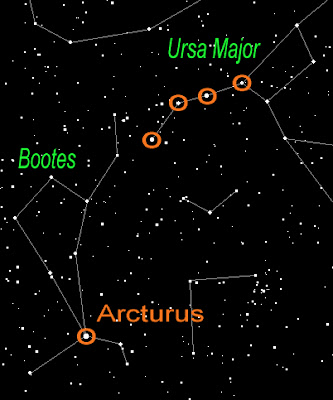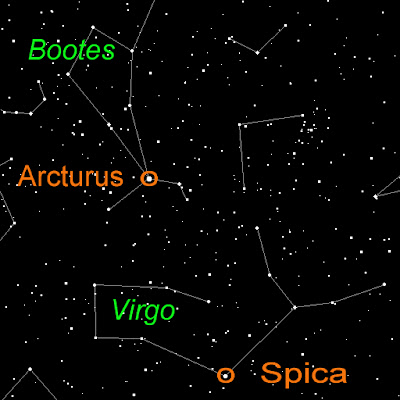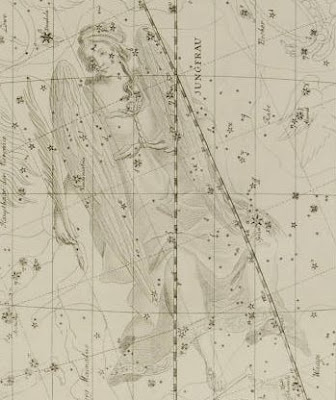1) About an hour after sunset, face east. If you don’t know the cardinal directions at your location and you don’t have a compass, make note of where the sun sets on the horizon. That spot is approximately west. Stand with your back to the west, and you’ll be facing approximately east.
2) Tilt your head back and look at the zenith, the point in the sky that’s directly overhead. A little ways to the left (toward the northern horizon) and just east of the meridian, you’ll find the distinctive seven-star asterism (recognizable star pattern) known as the Big Dipper. The Big Dipper is in the constellation Ursa Major the Big Bear.
Now extend the curve of the Big Dipper’s handle— heading away from the Dipper’s bowl— to the next star along that arc that‘s brighter than the end star of the handle. You’ve arced to Arcturus! Arcturus is the brightest star in the constellation Bootes the Herdsman.


3) To speed on to Spica, simply continue the arc past Arcturus to the next bright star. This is the blue-white dwarf star Spica (SPY-kuh), which is a bit dimmer than Arcturus. Spica lies 260 light years away. A light year is the distance light travels in one Earth year, nearly six trillion miles.
Spica is the brightest star in the constellation Virgo the Maiden. The name Spica comes from the Greek word for ear of grain. The figure of Virgo is associated with the harvest, and she is often depicted carrying an ear of grain.

Virgo in Johann Bode’s 1782 star atlas
Courtesy of Linda Hall Library of Science, Engineering and Technology
Courtesy of Linda Hall Library of Science, Engineering and Technology
The ancient star figure of Virgo is not easily apparent to the modern stargazer. Virgo is one of those constellations characterized by a loose, sprawling collection of nondescript stars with no showy asterisms. If it weren’t for luminous Spica punctuating the arc from Arcturus, most of us would be hard-pressed to locate the dowdy maiden at all.
But now you can arc to Arcturus and speed on to Spica. This is an easy asterism to teach others, and best of all, it covers ports of call in three constellations!

Astronomy Essential: A telescope gathers light; it does not magnify.
The function of any telescope— whether it uses mirrors, lenses, or both— is to gather light and focus it into a clear, bright image.
The eyepiece— the accessory that is inserted into the focuser and through which the observer peers— is the optical element that magnifies the image produced by the telescope. The magnification of the image, or power as it is also called, changes each time a different sized eyepiece is inserted into the telescope.